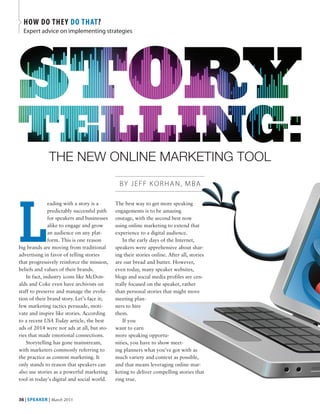
2015 Storytelling NSA
- 1. HOW DO THEY DO THAT? expert advice on implementing strategies L eading with a story is a predictably successful path for speakers and businesses alike to engage and grow an audience on any plat- form. This is one reason big brands are moving from traditional advertising in favor of telling stories that progressively reinforce the mission, beliefs and values of their brands. In fact, industry icons like McDon- alds and Coke even have archivists on staff to preserve and manage the evolu- tion of their brand story. Let’s face it; few marketing tactics persuade, moti- vate and inspire like stories. According to a recent USA Today article, the best ads of 2014 were not ads at all, but sto- ries that made emotional connections. Storytelling has gone mainstream, with marketers commonly referring to the practice as content marketing. It only stands to reason that speakers can also use stories as a powerful marketing tool in today’s digital and social world. The best way to get more speaking engagements is to be amazing onstage, with the second best now using online marketing to extend that experience to a digital audience. In the early days of the Internet, speakers were apprehensive about shar- ing their stories online. After all, stories are our bread and butter. However, even today, many speaker websites, blogs and social media profiles are cen- trally focused on the speaker, rather than personal stories that might move meeting plan- ners to hire them. If you want to earn more speaking opportu- nities, you have to show meet- ing planners what you’ve got with as much variety and context as possible, and that means leveraging online mar- keting to deliver compelling stories that ring true. the new online marKeting tool BY JEFF KORHAN, MBA 36 | SPEAKER | March 2015
- 2. Storytelling Tips for a Digital World To attract people to your stories online, you need to structure them for search. First, be mindful that meeting planners are probably not searching for a video of your 45-minute keynote, but some- thing more like a TED Talk—a human experience with a singular message that engages an audience. Then, just know that Google is get- ting very good at giving people what they want when searching the Web. Thus, optimizing for real people is always the best approach. In order of importance, here are the most relevant criteria for getting your story discov- ered, consumed, and acted upon, regardless of the media format. TITlE OR HEADlINE. This must com- municate the theme of your story—what it’s about. The headline must speak to the most relevant needs of your audience or the content will never be consumed. I published an article titled How to Use Social Media to Grow Your Email Subscribers on my site that has earned thousands of shares because it addresses a key pain point: how to use social media to achieve practical and prof- itable outcomes. META DESCRIPTION. The meta description is usually the first sentence or two that provides a concise descrip- tion of the blog post, video, podcast, etc. It must deliver on the promise of the headline; otherwise, Google and human beings alike will move on. My aforementioned social media article opens with a story about net- working at a conference with the world’s leading social media experts, which instantly establishes the validity of the content that follows. Note: Most content management platforms, such as WordPress, have capabilities for submitting a specific meta description, which is preferred over the default of Google choosing the first sentence or two. STRUCTURE. Online storytelling is not just about information; appearance matters. This is why modern websites strip away distractions, such as sidebars, to keep the focus on the useful content; that is, your story. Online audiences are scan- ning for valuable nuggets. Para- graphs should be no longer than three sentences. Subheads should be crafted just as carefully as the headline. The first sentence in my social media Jeff Korhan, MBA, is the author of Built-in Social and the host of This Old New Business podcast. He helps businesses adapt their tradi- tional sales and marketing practices to a dig- ital, social and global world. Find it all at JeffKorhan.com. article is intentionally dramatic: Email Subscribers Are Your Business Lifeline. Within the body copy, there should be attention-grabbing photos, videos, bulleted and numbered lists, and tweetable information in bold text or a call-out box. Better yet, use a service like Click To Tweet to create a ready- made tweet. ACTIVE VOICE. Don’t just tell your story; relive one active scene so that everyone can experience it with you for the first time. You want this story to be timeless content that never goes out of style, happily residing on the Web to “market” your business. Therefore, whenever possible, avoid any reference to time. CAll TO ACTION. Your story should inspire people to action, which may include subscribing to your newsletter or engaging them with your premium content, which ideally includes hiring you to speak. A common mistake is asking your audience to hire you. Instead, encour- age them to subscribe, so you can lever- age that permission to share more relevant stories that earn their trust. A well-told story is a gift that when properly shared can be the most effec- tive marketing any speaker can have for engaging and inspiring audiences to action. Given the enormous influence of the web on human behavior, it’s rea- sonable to assume these online prac- tices apply equally well to storytelling on any platform today.
